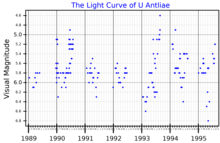우안트리아에
U Antliae| 관측 데이터 에폭 J2000 이쿼녹스 J2000 | |
|---|---|
| 별자리 | 안틀리아 |
| 우측 상승 | 10h 35m 12.852s[1] |
| 탈위임 | −39° 33′ 45.32″[1] |
| 겉보기 크기 (V) | 5.27 - 6.04[2] |
| 특성. | |
| 진화 단계 | AGB |
| 스펙트럼형 | C-N3[3](C5,3[4]) |
| U-B색지수 | 7.10[5] |
| B-V색지수 | 2.84[5] |
| 변수형 | LB[6] |
| 아스트로메트리 | |
| 방사 속도 (Rv) | 41.00km[7]/s |
| 고유 운동 (μ) | RA:-31.372±0.152mas[8]/yr Dec.:2.371±0.267[8]mas/yr |
| 시차 (π) | 3.5717 ± 0.2043[8] 마스 |
| 거리 | 910 ± 50 리 (105 ± 20 pc) |
| 절대치수 (MV) | −1.87[9] |
| 세부 사항 | |
| 반지름 | 325[10] R☉ |
| 루미도 | 8,000[11] L☉ |
| 온도 | 2800K[11] |
| 기타 지정 | |
| 데이터베이스 참조 | |
| 심바드 | 자료 |
좌표:![]() 10h 35m 12.8507s, −39° 33′ 45.319″
10h 35m 12.8507s, −39° 33′ 45.319″

U 안티애 주변의 먼지 껍질 ALAMA
U 앤틀리아(U Antliae, U Antlia)는 앤틀리아 별자리에 있는 변수별이다.그것은 두 개의 얇은 먼지 껍질로 둘러싸인 탄소 별이다.
U 앤티애(U Antliae)는 극도로 붉은 C형 탄소성이다.점증하지 않는 거대한 가지에 있는 이 시원한 별들은 항성 주위에 형성되는 강한 질량 손실과 먼지로 인해 더욱 붉게 물든다.U 앤티애는 72K의 온도에서 먼지로 둘러싸인 2,300K의 검은 몸체에서 우리에게 도달하는 빛이 더 많이 나타나지만 유효 표면 온도는 2,800K인 것으로 계산된다.[11]적외선에서 대부분의 방사선을 방출하며 시각 파장에서는 태양보다 약 500배 밝을 뿐이지만,[9] 대기압 광도는 태양보다 8,000배 높다.[11]
U 앤티애(U Antliae)는 겉보기 등급이 5.27~6.04인 불규칙 변광성이다.지구에서 약 900광년 떨어진 곳에, 그것은 14,000년과 1만년 전에 분출된 것으로 생각되는 두 개의 먼지 껍질로 둘러싸여 있다.[13]쉘의 정확한 기원과 구조는 불확실하며, 열 펄스 중에 질량 손실이 증가했기 때문일 수 있으며, 항성 바람과 성간 물질의 상호작용 때문일 수 있다.[11]
참조
- ^ a b van Leeuwen, F. (2007). "Validation of the new Hipparcos reduction". Astronomy and Astrophysics. 474 (2): 653–664. arXiv:0708.1752. Bibcode:2007A&A...474..653V. doi:10.1051/0004-6361:20078357. S2CID 18759600.Vizier 카탈로그 항목
- ^ Otero, Sebastian (3 November 2011). "U Antliae". AAVSO Website. American Association of Variable Star Observers. Retrieved 25 July 2014.
- ^ De Mello, A. B.; Lorenz-Martins, S.; De Araújo, F. X.; Bastos Pereira, C.; Codina Landaberry, S. J. (2009). "NSCC—A New Scheme of Classification of C-Rich Stars Devised from Optical and Infrared Observations". The Astrophysical Journal. 705 (2): 1298. arXiv:0910.4086. Bibcode:2009ApJ...705.1298D. doi:10.1088/0004-637X/705/2/1298. S2CID 119275102.
- ^ Yamashita, Y. (1975). "The C-classification of spectra of carbon stars. II". Tokyo. 15: 47. Bibcode:1975AnTok..15...47Y.
- ^ a b Ducati, J. R. (2002). "VizieR Online Data Catalog: Catalogue of Stellar Photometry in Johnson's 11-color system". CDS/ADC Collection of Electronic Catalogues. 2237. Bibcode:2002yCat.2237....0D.
- ^ Samus, N. N.; Durlevich, O. V.; et al. (2009). "VizieR Online Data Catalog: General Catalogue of Variable Stars (Samus+ 2007-2013)". VizieR On-line Data Catalog: B/GCVS. Originally Published in: 2009yCat....102025S. 1. Bibcode:2009yCat....102025S.
- ^ Gontcharov, G. A. (2006). "Pulkovo Compilation of Radial Velocities for 35 495 Hipparcos stars in a common system". Astronomy Letters. 32 (11): 759–771. arXiv:1606.08053. Bibcode:2006AstL...32..759G. doi:10.1134/S1063773706110065. S2CID 119231169.
- ^ a b c Brown, A. G. A.; et al. (Gaia collaboration) (August 2018). "Gaia Data Release 2: Summary of the contents and survey properties". Astronomy & Astrophysics. 616. A1. arXiv:1804.09365. Bibcode:2018A&A...616A...1G. doi:10.1051/0004-6361/201833051. 이 소스에 대한 가이아 DR2 기록 VizieR.
- ^ a b Alksnis, A.; Balklavs, A.; Dzervitis, U.; Eglitis, I. (1998). "Absolute magnitudes of carbon stars from HIPPARCOS parallaxes". Astronomy and Astrophysics. 338: 209. Bibcode:1998A&A...338..209A.
- ^ De Beck, E.; Decin, L.; De Koter, A.; Justtanont, K.; Verhoelst, T.; Kemper, F.; Menten, K. M. (2010). "Probing the mass-loss history of AGB and red supergiant stars from CO rotational line profiles. II. CO line survey of evolved stars: Derivation of mass-loss rate formulae". Astronomy and Astrophysics. 523: A18. arXiv:1008.1083. Bibcode:2010A&A...523A..18D. doi:10.1051/0004-6361/200913771. S2CID 16131273.
- ^ a b c d e Kerschbaum, F.; Ladjal, D.; Ottensamer, R.; Groenewegen, M. A. T.; Mecina, M.; Blommaert, J. A. D. L.; Baumann, B.; Decin, L.; Vandenbussche, B.; Waelkens, C.; Posch, T.; Huygen, E.; De Meester, W.; Regibo, S.; Royer, P.; Exter, K.; Jean, C. (2010). "The detached dust shells of AQ Andromedae, U Antliae, and TT Cygni". Astronomy and Astrophysics. 518: L140. arXiv:1005.2689. Bibcode:2010A&A...518L.140K. doi:10.1051/0004-6361/201014633. S2CID 55820070.
- ^ "Download Data". aavso.org. AAVSO. Retrieved 1 October 2021.
- ^ Izumiura, H.; Waters, L. B. F. M.; de Jong, T.; Loup, C.; Bontekoe, Tj. R.; Kester, D. J. M. (1997). "A double dust shell surrounding the carbon star U Antliae". Astronomy and Astrophysics. 323: 449–60. Bibcode:1997A&A...323..449I.




